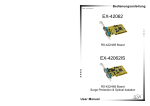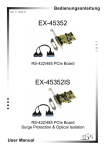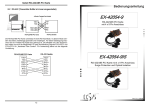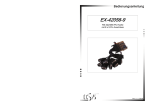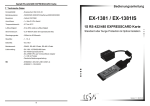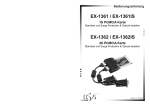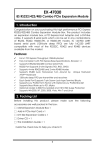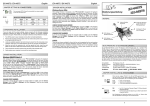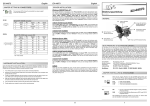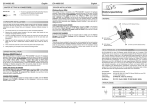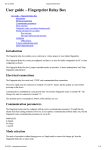Download EXSYS EX-45351
Transcript
Bedienungsanleitung Vers. 1.1 / 29.02.12 EX-45351 RS-422/485 PCIe Board EX-45351IS RS-422/485 PCIe Board Surge Protection & Optical Isolation User Manual Deutsch Seriell RS-422/485 PCIe Karte Inhaltsverzeichnis 1. Beschreibung ··························································································· 3 2. Paketinhalt ······························································································· 3 3. Layout und Jumper Einstellungen ··························································· 4 3.1 Layout ······················································································································· 4 3.2 Jumper Einstellungen ································································································ 4 4. 5. Hardware Installation ··············································································· 6 Treiber Installation ··················································································· 7 5.1 6. Verdrahtungsübersicht············································································· 8 6.1 6.2 6.3 7. Windows 98 / ME / 2000 / XP/ Vista und 2003 Server ··············································· 7 S1 und S2 Anschlussbelegung ················································································· 8 RS-485 (2 Draht) Verkabelung ················································································· 8 RS-422 (4 Draht) Verkabelung ················································································· 8 Technische Daten ···················································································· 8 Index 1. Description ······························································································· 9 2. Packet Content ························································································ 9 3. Layout and Jumper setting ···································································· 10 3.1 Layout ····················································································································· 10 3.2 Jumper Setting ········································································································ 10 4. Hardware Installation ············································································· 12 5. Driver Installation ··················································································· 13 5.1 6. Pin Assignments and Cable Wiring ······················································· 14 6.1 6.2 6.3 7. Windows 98 / ME / 2000 / XP/ Vista and 2003 Server ············································· 13 S1 and S2 Pin Assignments···················································································· 14 RS-485 (2-Wire) Wiring ·························································································· 14 RS-422 (4-Wire) Wiring ·························································································· 14 Technical Specification ·········································································· 14 2 Seriell RS-422/485 PCIe Karte Deutsch 1. Beschreibung Vielen Dank das Sie sich für die RS-422/485 PCIe Karte von EXSYS entschieden haben. Sie ist eine Add-On Karte für den PCI-Express-Bus für Desktop, Workstation oder Server um eine High-Speed Datenübertragung herzustellen. Der Serielle Port ist kompatible mit dem RS-422/485 Standard. Der Ausgang kann individuell als RS-485 mit 2 Draht, RS-485 mit 4 Draht oder RS-422 konfiguriert werden. Merkmale: • Kompatibel PCI Express Base Spezifikation Revision 1.1 • 128-byte On-Chip FIFO und Arbitrary Trigger Levels und Interrupts, Automatische Hardware/Software Flow Control • • • • • Bis 921.6 Kbps Baud Rate 5,6,7,8,9-bits Data Framing 1, 1.5 und 2 Stop Bits Unterstützt Echo Mode 15KV ESD Surge Protection und 2500Vrms Optical Isolation Protection (nur für EX-45351S) • Unterstützt Win98, ME, 2000, XP(32/64bit),Vista(32/64bit) Win7(32/64bit), WinCE und Linux 2. Packetinhalt Bevor Sie die RS-422/485 PCI-Express Karte in Ihren PC installieren, überprüfen Sie den Inhalt der Lieferung : • 1 x RS-422/485 Seriell PCIe Karte • 1 x LowProfile Bügel für schmale PC Gehäuse • 1 x Treiber CD • 1 x Bedienungsanleitung • Optional erhältlich 5 Pin Terminal Block (EX-47999) 3 Deutsch Seriell RS-422/485 PCIe Karte 3. Layout und Jumpereinstellungen 3.1 Layout JP5: Abschlusswiderstand Ein/Ausschalten JP2, JP4: RS-485TXD Control J1: Nur für Testzwecke im Werk J3: DB9 Stecker RS-422/485 Port JP3: RS-422/485 Mode Einstellung 3.2 Jumper-Einstellung Es gibt vier Jumper um den RS-422/485 Port einzustellen 1. Mode Einstellungs-Jumper: JP3 2. Abschlusswiderstand Jumper: JP5 3. Echo oder No Echo Jumper: JP4 4. TXD Control Einstellungs-Jumper: JP2 1. Mode Einstellungen (JP3): 485-2W 422 485-4W 485-2W = RS-485 Mode mit 2 Draht Leitung (Werkseinstellung) 485-4W = RS-485 Mode mit 4 Draht Leitung 422 = RS-422 Mode 4 Seriell RS-422/485 PCIe Karte Deutsch 2. Abschlusswiderstand Ein/Aus (JP5): Diese Jumper aktiviert oder deaktiviert den 120 Ohm Abschlusswiderstand zwischen DATA+ und DATA– des RS-485 Transceiver: OFF ON OFF ON = Abschlusswiderstand Ausgeschaltet (Werkseinstellung) = Abschlusswiderstand Eingeschaltet 3. Echo oder No Echo Einstellung (JP4): Der “Echo Mode” ist für das Anwendungsprogramm nützlich um zu erkennen ob der RS-485 “Bus” in einem Konflikt steht. Sind die zurückgesendeten Daten nicht die gleichen was gesendet wurde, ist der RS-485 Bus überlastet und die Daten werden nicht korrekt übermittelt. Diese Einstellung betrifft nur den RS-485 Mode mit 2 Draht. Es hat keinen Einfluss auf die Modi RS-485 mit 4 Draht oder RS-422. OFF ON OFF = No Echo Data (Werkseinstellung) ON = Echo bei der Übermittlung der Daten 4. TXD Control Einstellung (JP2): Dieser Jumper wird verwendet im Mode RS-485 um das Steuersignal des SenderPuffer zu kontrollieren. Es hat zwei Einstellungen. Die erste ist „MAN“ (manuell) und die zweite ist „AUT“ (automatisch). Die zweite ist die Werkseinstellung und sollte nicht verstellt werden. MAN AUT AUT ON = = TXD Control ist automatisch (Werkseinstellung) TXD Control ist manuell (Muss manuell im Geräte Manager konfiguriert werden) 5. TXD Control Einstellung (J1): Die Stecker-Leiste J1 ist nur für Testzwecke im Werk. Bitte installieren sie keine Jumper oder Kabel. 5 Deutsch Seriell RS-422/485 PCIe Karte 4. Hardware Installation Beachten Sie die folgenden Installationshinweise. Da es grosse Unterschiede bei Computern gibt, können wir Ihnen nur eine generelle Anleitung zum Einbau der RS-422/485 PCI Karte geben. Bei Unklarheiten halten Sie sich bitte an die Betriebsanleitung Ihres Computersystem. • Schalten Sie Ihren Rechner und alle angeschlossenen Peripheriegeräte aus und ziehen Sie bei allen Geräten den Netzstecker. • Lösen Sie die Schrauben des Gehäuses auf der Rückseite Ihres Computers und entfernen Sie vorsichtig das Gehäuse. • Suchen Sie einen freien PCI-Express-Slot und stecken Sie die RS-422/485 PCI Karte vorsichtig in den ausgewählten PCI-Express-Slot ein. • Beachten Sie das die RS-422/485 PCI Karte korrekt eingesteckt wird und das kein Kurzschluss entsteht. • Danach befestigen Sie die PCI-Express Karte mit einer Schraube am Gehäuse. • Jetzt Computergehäuse mit den gelösten Schrauben wieder schliessen. 6 Seriell RS-422/485 PCIe Karte Deutsch 5. Treiber Installation Anmerkung! Bitte lassen Sie Windows nicht automatisch nach den Treibern suchen, da dies wegen den INF Files zu Problemen führen könnte. Stattdessen durchsuchen sie manuell den Treiber an der richtigen Stelle (Ordner) auf der mitgelieferten CD. Bild 1 Die Treiber finden Sie in dem Order für das installierte Betriebssystem. 5.1 Windows 98, ME, 2000, XP, Vista, Win7 und Server 2003 / 2008 Windows startet automatisch den Hardwareassistenten um die Treiber zu installieren. Klicken sie auf >Weiter<. Legen sie die Treiber CD in Ihr CD-ROM Laufwerk ein (z.B. Laufwerk D:). Wählen sie „Nach einem passenden Treiber für das Gerät suchen (empfohlen)“ und klicken sie auf >Weiter<. Wählen sie jetzt „Andere Quelle angeben“ und geben sie dann den Pfad für ihr Betriebssystem wie auf Bild 1 gezeigt ein. Klicken Sie dann auf >Weiter< und zum Abschluss auf >Fertigstellen<. 7 Deutsch Seriell RS-422/485 PCIe Karte 6. Verdrahtungsübersicht 6.1 Anschlussbelegung DB 9M 9 Pin D-SUB Stecker (S1 und S2) Pin Signal Pin Signal Pin Signal 1 TXD- (DATA-) 4 RXD- 7 2 TXD+ (DATA+) 5 GND 8 3 RXD+ 6 6.2 9 RS-485 (2 Draht) Verkabelung DATA(-) Pin 1 Pin 1 DATA (-) DATA(+) Pin 2 Pin 2 DATA (+) Ground Pin 5 Pin 5 Ground RS-422/485 PCI Karte 6.3 RS-485 Geräte RS-425 (4 Draht) Verkabelung TXD(-) TXD(+) RXD(+) RXD(-) Ground Pin 1 Pin 2 Pin 3 Pin 4 Pin 5 RS-422/485 PCI Karte 7. Technische Daten Stromaufnahme: Betriebstemperatur: Betriebs Luftfeuchtigkeit: 12V DC, 150mA (max.) 3.3V DC, 95mA (max.) 00 bis 550C (320 bis 1310F) 5% bis 95% RH 8 Pin 1 Pin 2 Pin 3 Pin 4 Pin 5 TX(-) TX(+) RX(+) RX(-) Ground RS-485 Geräte Seriell RS-422/485 PCIe Board English 1. Description Thank you for purchasing this 1-Port RS422/485 Serial PCI-Express Card. It is a universal add on card that connects to a PC or server via the PCIe Bus, providing highspeed serial connectivity. The serial ports are fully compatible with RS422/485 standard by the bundled Serial COM port drivers. It can be set at any mode (RS485 2-wire, RS485 4-wire and RS422) for different type connections. Feature: • Fully Compliant with PCI Express Base Specifications, Revision 1.1 • 128-byte On-Chip FIFO and Arbitrary Trigger Levels and Interrupts, Automatic Hardware/Software Flow Control • • • • • Up to 921.6Kbps Baud Rate Supports 5,6,7,8,9-bits Data Framing Supports 1, 1.5, 2 Stop Bits Support Echo Mode 15KV ESD Surge Protection and 2500Vrms Optical Isolation Protection (only for EX-45351IS) • Support Win98, ME, 2000, XP(32/64bit),Vista(32/64bit), Win7(32/64bit) WinCE and Linux 2. Packet Content Before you install the RS-422/485 PCIe card in your PC, check the contents of delivery: • 1 x RS-422/485 Serial PCI card • 1 x LowProfile bracket for small computer case • 1 x Driver CD • 1 x User Manual • Optional 5 Pin Terminal Block (EX-47999) 9 English Seriell RS-422/485 PCIe Board 3. Layout and Jumpersetting 3.1 Layout JP5: Terminator Enable / Disable JP2, JP4: RS-485TXD Control J2: Factory Use Only J3: DB9 male RS-422/485 port JP3: RS-422/485 Mode Selector 3.2 Jumper setting There are 4 jumpers listed as following to set the settings for the RS-422/485 port: 1. 2. 3. 4. Mode Selection Jumper: JP3 Termination Resistor Enable/Disable Jumper: JP5 Echo or No Echo Selection Jumper: JP4 TXD Control Selection Jumper: JP2 1. Mode Setting (JP3): 485-2W 422 485-4W 485-2W = 485-4W = 422 = RS-485 Mode with 2-wire (Default) RS-485 Mode with 4-wire RS-422 Mode 10 Seriell RS-422/485 PCIe Board English 2. Termination Resistor Enable/Disable (JP5): This jumper enables/disables the 120 Ohm termination resistor between DATA+ and DATA- of the RS485 transceiver: OFF ON OFF ON = = Termination Resistor Disabled (Default) Termination Resistor Enabled 3. Echo or No Echo Settings (JP4): This jumper is to set the transmission data will be echoed back or not. The Echo mode is useful for the application program to detect if the RS485 bus has collision. If the echoed data was not equal to the transmitted data, then the bus was in a collision. This setting only affects the RS485 2-wire mode. It doesn’t affect RS485 4wire, RS422, and RS232 modes. OFF ON OFF ON = = No Echo Data (Default) Transmission data will be echoed 4. TXD Control Setting (JP2): This jumper is used to select the control signal for the transmitter buffer in RS485 2wire mode. There are 2 settings are selectable, one is “MAN” (manually) the other one is “AUT” (automatically, factor default), please keep it at “AUT” in all cases. MAN AUT AUT = TXD Control is Automatic (Default) ON = TXD Control is Manual (Needs to be Configured Manually in the Device Manager) 5. Factory Use Only Connectors (JP2): This connector is only used for factory production purpose, please don’t install any jumper or cable on it! 11 English Seriell RS-422/485 PCIe Board 4. Hardware Installation • • • • Turn the system power OFF before installation! • Plug the RS422/485 PCIe card to the unused PCI-Express expansion slot and attached the I/O card bracket to the computer chassis screw. • • • Put the chassis cover back on the computer. Use static electricity discharge precautions. Remove the chassis cover from your computer Locate an unused PCI-Express slot (typically white or ivory) and remove the corresponding slot cover from computer chassis. Turn ON the power of your computer and peripherals. Proceed with Software Driver Installation. 12 Seriell RS-422/485 PCIe Board English 5. Driver Installation Note: PLEASE DO NOT LET WINDOWS AUTO SEARCH THE DRIVERS ON THE CD, it will cause problems because the INF files will be conflict in this case. Instead, please browse to the correct location (folder) manually to make sure the correct drivers are chosen and installed correctly. Bild 1 Drivers are in each corresponding folder 5.1 Windows 98, ME, 2000, XP, Vista, Win7 and Server 2003 / 2008 1. When the system is powered, Windows will invoke Windows’ New Hardware Wizard. Click〝 Next 〞to continue, select〝 Install from a list or specific location( (Advanced) ) 〞and click〝 Next 〞. 2. Select〝 Include this location in the search 〞then click〝 Browse 〞to specify the driver’s location for your OS (for example, XP is E:\IO\OXFORD2\XP32) and click〝 Next 〞to continue. 3. Click〝 Next 〞to continue, and click〝 Finish 〞to complete the installation. 4. To check the Installation, right click on〝My Computer〞and choose 〝Manage〞. Choose〝 Device Manager 〞and double click〝 Ports 〞. 13 English Seriell RS-422/485 PCIe Board 6. Pin Assignments and Cable Wiring 6.1 Pin connection DB 9M 9 Pin D-SUB male connector Pin Signal Pin Signal Pin Signal 1 TXD- (DATA-) 4 RXD- 7 2 TXD+ (DATA+) 5 GND 8 3 RXD+ 6 6.2 9 RS-485 (2-wire) Cable Wiring DATA(-) Pin 1 Pin 1 DATA (-) DATA(+) Pin 2 Pin 2 DATA (+) Ground Pin 5 Pin 5 Ground RS-422/485 PCI card 6.3 RS-485 Device RS-425 (4-wire) Cable Wiring TXD(-) TXD(+) RXD(+) RXD(-) Ground Pin 1 Pin 2 Pin 3 Pin 4 Pin 5 RS-422/485 PCI card 7. Technical Specification Power requirements: Operating temperature: Operating humidity: 12V DC, 150mA (max.) 3.3V DC, 95mA (max.) 00 to 550C (320 to 1310F) 5% to 95% RH 14 Pin 1 Pin 2 Pin 3 Pin 4 Pin 5 TX(-) TX(+) RX(+) RX(-) Ground RS-485 Device
This document in other languages
- Deutsch: EXSYS EX-45351IS
















